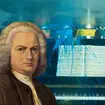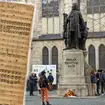Bach - Magnificat
Written in 1723, Bach's exciting Baroque masterpiece was the first piece he offered to the people of Leipzig.
In 1723, J. S. Bach was a young composer and music teacher with a large family to support. Shortly before Christmas that year, soon after he had been appointed the Director of Music and Organist of St Thomas’s Church in Leipzig, Bach wanted to introduce himself to the city with a work that showed off all his brilliant potential. Realising that a lot of church music was often long and hard work for the audience, Bach decided to grab their attention with something short, sharp and stunning.
Taking the Latin text of the story of the Virgin Mary as told in the Gospel of St. Luke, Bach wrote a version in E-flat major of the Magnifcat, to be performed for Christmas Vespers. Ten years later, he adapted that version in D major, to be performed at the feast of the Visitation in July, taking out certain of the texts which related specifically to Christmas.
The work has 12 movements and lasts just half an hour. Bach treats each of the movements like a distinct picture in a gallery. What the people of Leipzig heard was a cheerful, bright and brilliant sound world, with every note of the music designed to embellish the words. It's a show-off piece in which all the singers are also challenged to dazzle the listener with their technical mastery.
The people of Leipzig must have liked it - Bach stayed there for the rest of his life giving them the first performances of all the cantatas he wrote, all of his organ music, and other great choral works including the St Matthew and St John Passions, and his B Minor Mass.


























